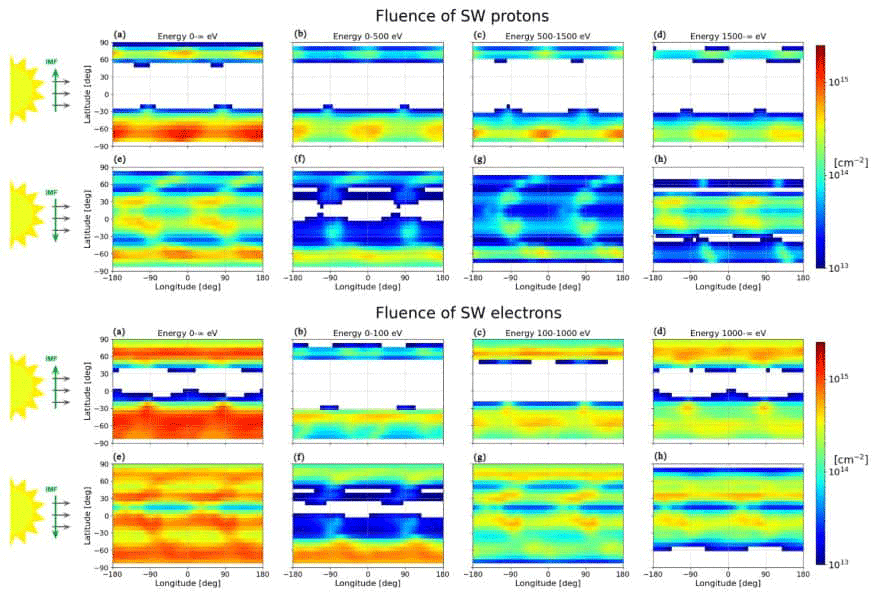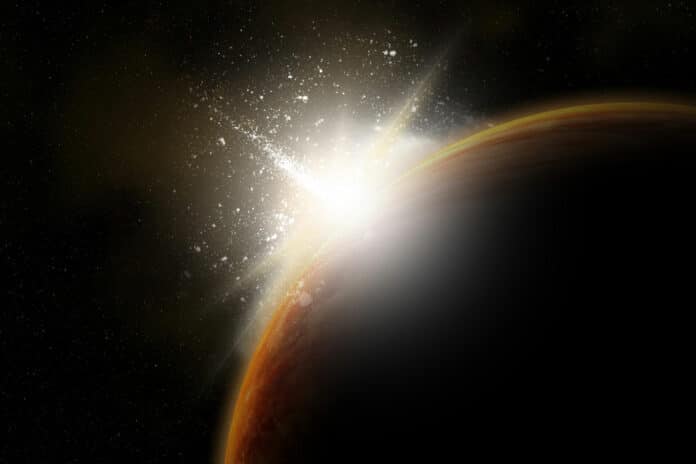Mercury is the closest planet to the Sun, possesses a weak intrinsic magnetic field, and has only a very tenuous atmosphere. These three conditions result in a direct coupling between the plasma emitted from the Sun and Mercury’s surface.
Mercury’s magnetic field leads to a nontrivial pattern of plasma precipitation onto the surface that is expected to contribute to the alteration of the regolith over geological timescales. A new study aims to determine the solar wind plasma precipitation onto the surface of Mercury from a geographical perspective.
This is one of the first works to examine in detail the effects of the solar wind-charged particles on the surface of Mercury as a function of the position on the surface and the energy of the infalling protons and electrons. This is significant for scientists who study the surface’s properties.
Scientists used solar wind precipitation maps for protons and electrons from two fully kinetic numerical simulations of Mercury’s plasma environment. They then integrated these maps over two complete Mercury orbits. They found that the plasma precipitation pattern at the surface is most strongly affected by the upstream solar wind conditions, particularly the interplanetary magnetic field direction, and less by Mercury’s 3:2 spin–orbit resonance.

Scientists also found that Mercury’s magnetic field can shield the surface from roughly 90% of the incoming solar wind flux. At the surface, protons have a broad energy distribution from below 500 eV to more than 1.5 keV, while electrons are primarily found in the 0.1–10 keV range.
Planetary Science Institute Senior Scientist Elizabeth A. Jensen, a co-author on the paper, said, “We are trying to understand where the protons and electrons hit the surface and build up physical effects on the regolith and atmosphere in the process. In previous maps, they show how many protons and electrons hit the surface at a certain time of day. But, for example, dawn occurs at all places across the surface. So you might think the amount of protons and electrons hitting the surface should be the same.”
“However, Mercury has this really strange orbit and rotation property. For every two times Mercury orbits the Sun, it turns on its axis three times. We call this a 3-to-2 spin-orbit resonance. The Mercury Day lasts a little less than a Mercury year. Not only that, but Mercury also spends more time with some longitudes facing the Sun than others. Also, the orbit is elliptical, not circular, so the amount of material from the solar wind is different on average depending on where in the orbit it is.”
“Mapping the infall of these particles not only needs to account for the spin-orbit resonance and the location within the elliptical orbit but also the interactions of the solar wind with Mercury’s magnetic field. It’s a complicated system with many moving parts.”
“To convert the time-of-day maps to geographic maps, the modeling results describing the infall of protons and electrons from the solar wind through Mercury’s magnetic field were integrated over the time span equivalent to a full Mercury day, lasting roughly two full orbits of Mercury around the Sun.”
Domingue said, “Does this mean that solar winds alter the regolith on the surface of Mercury? Yes, the solar wind does alter the surface. The interaction of the solar wind helps generate the exosphere, which is a very thin atmosphere, and space weathers the minerals that comprise the surface.”
“This paper does not focus on the generation of the exosphere or the space weathering of the surface, but provides the information of the variation in the radiation flux across the surface that is needed for those who study these phenomena.”
Journal Reference:
- Federico Lavorenti, Elizabeth A. Jensen, Sae Aizawa, et al. Maps of Solar Wind Plasma Precipitation onto Mercury’s Surface: A Geographical Perspective. The Planetary Science Journal. DOI: 10.3847/PSJ/acef15
